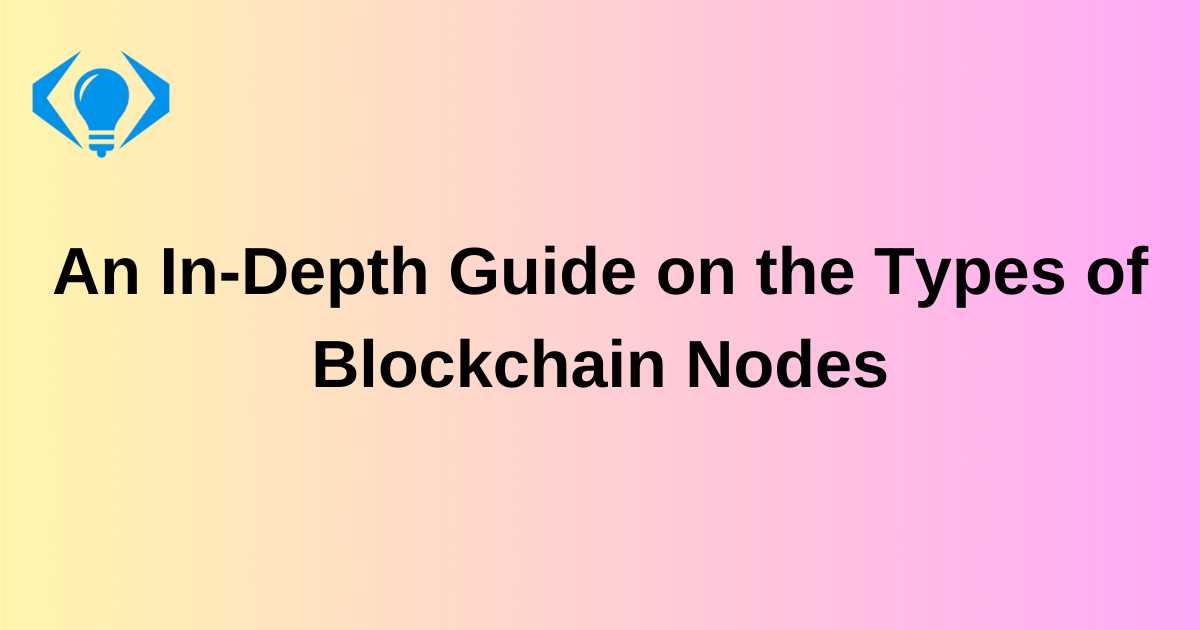
The Art of Effective Customer Relationship Management: Strategies for Retention
February 22, 2023
11 Influencer Marketing Platforms to Use for Your Next Campaign
March 15, 2023The popularity of blockchain technology is growing worldwide. Businesses and individuals across the globe are leveraging blockchain for various purposes.
Whether it’s cryptocurrencies, IT, or healthcare, blockchain is spreading its wings in every dimension.
However, this concept is still new to most of the global population. While many still are in two minds regarding the security and credibility of blockchains, others want to explore the concept more.
If you are interested to learn the technology, understanding blockchain nodes is crucial. If you are a business or blockchain enthusiast wanting to develop a secure and affordable blockchain-based solution, knowledge about blockchain nodes will help you.
So, let’s understand blockchain nodes in-depth and their types.
What is Blockchain?
A blockchain is an immutable shared ledger storing transactions and tracking assets in a network. It’s a database where data is arranged in blocks instead of rows and columns, as seen in traditional databases.
The term “blockchain” is derived from two words – “block” and “chain”. Each verified transaction or record in a blockchain network is added to a block with a defined space. If this space is filled, new verified records are added to the next block attached or “chained” to the previous block through cryptography.
Blockchain technology was invented in 2008 by Satoshi Nakamoto, whose identity is unknown.
Its key elements are:
- Decentralization: Blockchain is a decentralized system that no single person owns, and anyone with permission can access it. It is also called the Distributed Ledger Technology (DLT) since it’s a distributed ledger containing related records and allowing users to store, share, and perform peer-to-peer transactions.
- Immutability: Each record in a blockchain is timestamped to avoid tampering and double records. If there’s an error in a record, a new record with a correction needs to be added so that both records are visible.
- Transparency: Most blockchains, except private ones, are open-source with no central authority. Hence, anyone can access its code and suggest changes, which increases mutual trust and transparency between members of the network.
Blockchain technology is used in different industries, from banking and finance to IT, supply chain, and healthcare. Its usage is growing fast, and you can also see businesses using the technology in video games, smart contracts, document verification, payments, and more. It is not only secure, cost-efficient, and easy to use but also faster and more accurate.
What are blockchain nodes?
Blockchain nodes are electronic devices with an IP address and connected to a blockchain network via the internet. Nodes are communication endpoints that allow users to interact with a blockchain.
Nodes enable a blockchain system to execute. It’s like a playground where everything happens. This playground consists of multiple blockchain platforms that can be private, public, or hybrid.
A blockchain node can perform different functions based on the requirements of the blockchain. Some of the basic tasks it can perform are:
Facilitating communication
Accepting or rejecting a transaction
Processing a transaction
Managing transactions
Storing blocks linked with cryptography
Why do you need blockchain nodes?
Blockchain technology ensures data integrity and enhances the network’s credibility. For this, the same ledger is distributed globally amongst multiple systems.
Since every block containing data in a blockchain is connected to the subsequent block via cryptography, if you want to change a record or block, you will need to change all the subsequent blocks. It’s done to maintain accuracy and consistency because each block has the hash of the previous block.
So, imagine if a blockchain network is confined to a single place. It will become easier for a hacker to modify block values and exploit the network. This is why blockchain is distributed around the world with no central hub administering it; hence, the concept of decentralization was implemented.
Furthermore, every connected system or node spread worldwide will share the same data in order to preserve the network’s data integrity and accuracy. Even if one system’s ledger is modified, other systems containing this ledger will remain unsullied and act as proof of data integrity. This global distribution of blockchain among several nodes also enhances network resilience to attacks and natural calamities while increasing trustworthiness.
You need blockchain nodes for:
Enabling access: Blockchain nodes allow users to access a blockchain ledger easily. It will help you interact with the network seamlessly so you can view transactions occurring in the network, see the transaction details, and verify the records.
Maintaining the blockchain: Nodes maintain a blockchain network and help it grow. Each data block in the blockchain is added to a node’s storage. Next, the nodes are used to add new blocks to the network and synchronize the data, maintaining the ledger’s copy. To finally approve a block to be added to a blockchain, it must achieve consensus by a majority of the members.
Transaction processing: When a transaction happens in a blockchain, it is sent to its nodes. Some nodes participate in the network’s consensus algorithm based on their roles, while others are responsible for record-keeping.
Upon receiving a transaction request, the node can either accept or reject the transaction. It can store this data and send it back to the network’s peers. A node can also share the data with other nodes in the network to promote synchronization.
How do blockchain nodes work?
So far, we have learned that blockchain technology maintains data integrity. But what really goes behind the curtains is what we will learn next.
To maintain data integrity, everyone in the network must know that each transaction is valid and there are no double records to facilitate any cheating.
Since there is no central authority to manage the network, achieving consensus is the way members can verify whether the transactions are valid or not. Network nodes achieve this among users and help secure a blockchain.
Consensus can have a set of rules for a blockchain to operate and confirm data validity. Since the blockchain can be large with a vast number of systems and users, a consensus algorithm is required to validate the information in the blocks. Proof of Work (PoW) and Proof of Stake (PoS) are popular consensus algorithms relying on nodes (full nodes) to enforce network rules and validate transactions.
Example: Bitcoin uses the PoW algorithm. Anyone is allowed to download the Bitcoin blockchain and verify blocks. This enables the network to be decentralized and increases its security. In this blockchain, anyone can run bitcoin nodes with a stable internet connection and proper hardware.
Types of Blockchain Nodes
There are different types of nodes providing different functionality. Even users interacting with a blockchain network can be called nodes. However, not every device in a blockchain network is a node and performs the same function.
Nodes in a blockchain network are classified depending upon their roles and the blockchain’s requirements. For example, a node can be used to maintain transaction records while other nodes might not perform this task.
A blockchain can have different nodes for users, clients, service providers, and others.
Let’s look at the different types of blockchain nodes.
#1. Full Nodes
Full nodes are responsible for maintaining the entire transaction records in a blockchain network. They are regarded as the blockchain’s servers where the data is stored and maintained.
There are several governance models of a blockchain that full nodes can come under. If there are any improvements to be made to a blockchain, a majority of full nodes must be ready for it. So, it can be concluded that full nodes are given voting power in order to make any changes in a blockchain.
However, certain scenarios can also arise when a change is not implemented even after the majority of full nodes agree to the change. It can happen when a big decision has to be made.
For example, around 52% of full nodes agree to a change, but 48% do not (which is a close enough number). In such a case, a hard cryptocurrency fork may happen where the blockchain would be divided in half, and the action is non-backward compatible. When this happens, the newly created blockchain will work based on the changes suggested by the majority of full nodes, while the old blockchain continues to work like before.
There are two types of full nodes:
Pruned Full Nodes
Pruned nodes are given a specific memory capacity to store data. This means that any number of blocks can be added, but a full node can store only a limited number of bocks.
To maintain the ledger, pruned nodes can keep on downloading the block till it reaches the specified limit. Once the limit is attained, the node starts deleting the oldest blocks and making space for new ones in order to maintain the blockchain’s size. Nevertheless, it does not delete the old blocks completely since their sequence and metadata are still recorded in the blockchain, adhering to the Blockchain’s technology’s key principles.
Archival Full Nodes
Full nodes of this type are commonly found in a blockchain network. Archival full nodes maintain the complete blockchain, and they differ from pruned full nodes in terms of memory capacity. These nodes are of different types:
Miner nodes: You require certain nodes for high computations and solving complicated mathematical functions in order to verify records. This requires heavy computational power and consumes a high amount of energy in the process. Miner nodes are perfect for the mining process, which involves consensus algorithms like Proof of Work.
Authority nodes: Anyone can become a member or node in a public blockchain by syncing blockchain data in their systems. But in some cases, the blockchain must be administrated, and data must be secured. This is where authority nodes come into play. They are used to authorize other nodes wanting to join a blockchain network. They can also define the access permissions of other nodes if they want to access a specific data channel.
Masternodes: They are full nodes with no power to add a new block to the network. They are used to maintain the ledger and verify transactions.
Staking nodes: These nodes validate transactions in a blockchain network and are responsible for maintaining the consensus algorithm. In the famous algorithm – Proof of Stake (PoS), staking nodes are used to stake or invest their money and verify the transaction. If they are successful at validating the transaction, they will get some rewards in return.
The staking nodes are selected based on defined rules like time spent on the blockchain network. These full nodes don’t need heavy computation power.
#2. Light Nodes
Light nodes are used to store data and provide only the required information to facilitate daily tasks or enable faster transactions. These nodes are also known as Simplified Payment Verification (SPV) nodes. These nodes don’t validate the blocks; instead, they just store headers of blocks.
#3. Super Nodes
Super nodes are used to perform certain special tasks and are implemented in some blockchains. It can be used to set or maintain the rules of a blockchain, implement a change in the protocol, etc.
#4. Lighting Nodes
Lighting nodes build an individual with a user, pushing all the transactions to the main blockchain. This facilitates instantaneous transactions while reducing the cost involved in the transaction since the load gets reduced on the network.
These types of nodes were created to solve the issue of blockchain network congestion which delays transactions.
Conclusion
Knowledge of blockchain nodes and their types can help you create cost-effective, secure, and faster applications to solve your customer’s pain points. Thus, if you are a business or individual wanting to explore blockchain technology, this article will help you understand blockchain nodes and their importance.




